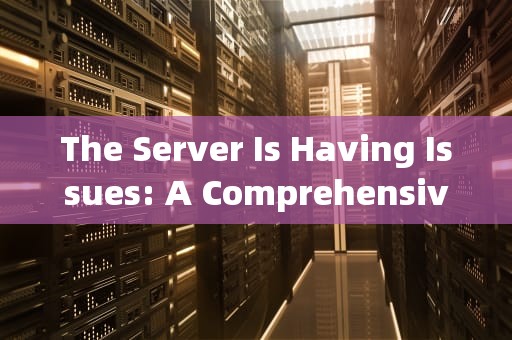In today's digital age, servers are the backbone of modern enterprises. They host websites, manage databases, and support a myriad of applications that keep businesses running smoothly. However, even the most robust systems can encounter issues from time to time. Whether you're an IT professional or a business owner, knowing how to identify and resolve server problems is crucial for minimizing downtime and ensuring operational continuity. This article aims to provide a comprehensive guide to troubleshooting common server issues and implementing effective solutions.

Recognizing the Symptoms of Server Problems
The first step in addressing server issues is recognizing the signs that something is wrong. Common symptoms include:
Slow Performance: If your server suddenly becomes sluggish, it could be due to high CPU usage, insufficient memory, or network congestion.
Frequent Crashes or Reboots: Unexplained reboots or crashes may indicate hardware failures, software bugs, or overheating.
Error Messages: Keep an eye out for recurring error messages in logs, which can provide clues about the underlying issue.
Unusual Noises: Strange sounds coming from the server room might suggest hardware problems like failing fans or drives.
Network Connectivity Issues: If clients cannot connect to the server or experience intermittent connectivity, there could be network configuration problems or hardware faults.
Common Causes of Server Problems
Understanding the potential causes behind server issues can help narrow down the troubleshooting process. Some frequent culprits include:
Hardware Failures: Faulty RAM, hard drives, or power supplies can lead to system instability.
Software Conflicts: Incompatible software installations or updates can cause conflicts that affect server performance.
Overheating: Inadequate cooling can result in thermal throttling or automatic shutdowns to prevent damage.
Security Breaches: Malware infections or unauthorized access attempts can compromise server functionality.
Configuration Errors: Misconfigured settings in operating systems, applications, or network devices can disrupt services.
Resource Exhaustion: Running out of CPU, memory, or disk space can slow down or halt server operations.
Troubleshooting Steps
When faced with a server problem, a systematic approach to troubleshooting is essential. Here’s a step-by-step guide:
1、Check Logs: Review system, application, and security logs for any error messages or anomalies around the time the issue started.
2、Monitor Resource Usage: Use monitoring tools to check CPU, memory, disk, and network usage. Look for spikes or patterns that could indicate resource exhaustion or bottlenecks.
3、Inspect Hardware: Physically inspect the server for signs of hardware failure such as blinking lights, unusual noises, or overheating components.
4、Update Software: Ensure all software, including the operating system and installed applications, is up to date with the latest patches and updates.
5、Scan for Malware: Run antivirus and antimalware scans to rule out security breaches as the cause of the issue.
6、Review Configuration Settings: Double-check configuration files and settings for any recent changes or misconfigurations that might have triggered the problem.
7、Isolate the Issue: If possible, reproduce the issue on a test environment to isolate the cause without affecting production systems.
8、Consult Documentation: Refer to manufacturer documentation, community forums, and support resources for known issues and recommended fixes.
Implementing Solutions
Once you’ve identified the root cause of the server problem, it’s time to implement a solution. Here are some strategies:
Replace Faulty Hardware: If hardware failure is detected, replace the faulty component promptly to restore functionality.
Optimize Resource Allocation: Adjust resource allocation settings based on monitored usage patterns to ensure efficient utilization.
Reconfigure Settings: Correct any misconfigurations identified during the troubleshooting process.
Apply Security Patches: Install necessary security updates to protect against vulnerabilities.
Upgrade Infrastructure: Consider upgrading server hardware or software if they no longer meet the demands of your applications or workload.
Implement Redundancy: For critical systems, implement redundancy measures such as backup servers or failover mechanisms to minimize downtime in case of failures.
Preventive Maintenance Tips
To reduce the likelihood of future server problems, consider implementing these preventive maintenance practices:
Regular Backups: Schedule regular data backups to ensure quick recovery in case of data loss.
Monitoring Tools: Use real-time monitoring tools to track server health and performance metrics proactively.
Capacity Planning: Periodically assess your server’s capacity needs and plan for upgrades before reaching maximum utilization.
Security Audits: Conduct regular security audits and penetration testing to identify and address potential vulnerabilities.
Documentation: Maintain thorough documentation of all server configurations, changes, and incidents for easy reference during troubleshooting.
Conclusion
Server issues can disrupt business operations and lead to significant financial losses if not addressed promptly. By being vigilant about monitoring server health, understanding common causes of problems, and following a structured troubleshooting process, IT professionals can effectively mitigate risks and maintain system stability. Remember, prevention is always better than cure when it comes to server management. Regular maintenance, proactive monitoring, and staying updated with industry best practices are key to keeping your servers running smoothly and securely.
随着互联网的普及和信息技术的飞速发展台湾vps云服务器邮件,电子邮件已经成为企业和个人日常沟通的重要工具。然而,传统的邮件服务在安全性、稳定性和可扩展性方面存在一定的局限性。为台湾vps云服务器邮件了满足用户对高效、安全、稳定的邮件服务的需求,台湾VPS云服务器邮件服务应运而生。本文将对台湾VPS云服务器邮件服务进行详细介绍,分析其优势和应用案例,并为用户提供如何选择合适的台湾VPS云服务器邮件服务的参考建议。

工作时间:8:00-18:00
电子邮件
1968656499@qq.com
扫码二维码
获取最新动态
